First live field demos of tracked Xerion 12
18th October 2024
The Xerion 12 has been added to the Claas Terra Trac range, and has just had its first live field demos in the UK. Neale Byart reports.
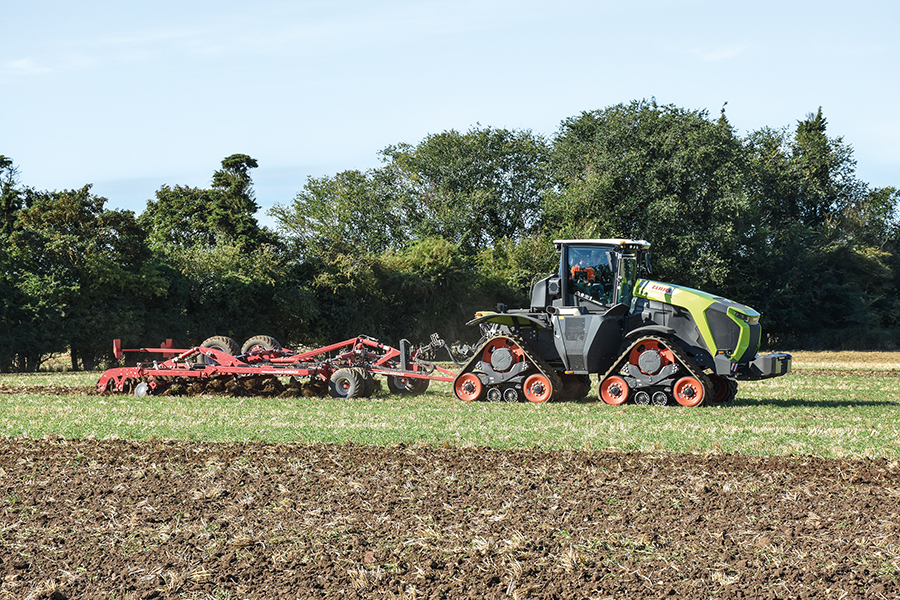
Terra Trac refers to the tracked versions of Claas’ agricultural machinery. Until recently, Terra Trac was only available on the Lexion combine harvester, the Jaguar forage harvester and the Axion tractor. Now, a new Terra Trac is available in the shape of the Xerion 12.
Claas dealer, Manns of Saxham, recently held a Terra Trac roadshow at R H Forrest in Suffolk, and Farmers Guide was invited to see and drive the Xerion 12 and Axion 900.
Tracks will spread the load of the machine over a greater surface area and are therefore much better for the soil. Less concentrated weight equals less compaction, and compaction has proven to be a serious problem with modern machines getting ever larger and heavier.
Soil compaction causes a reduction in pore spaces within the soil, oxygen deficiency, reduced micro-organisms and drainage problems, ultimately leading to reduced yields. While compaction is reversable, avoiding it in the first place will save both time and money.
Axion 900
The Axion 900 has been around for a few years and uses Claas’ traditional Terra Trac system of two wheels and an oval track, or ‘flat track’ as Claas calls it. This system is like that seen on the Claas combine and forager ranges with some modifications for cultivation draft work, such as a larger rear drive wheel.
A combine or forager will have equal-sized idler wheels, as it is designed more around carrying its weight vertically, whereas the Axion has the additional need to pull weight horizontally, hence the slightly larger rear drive wheel. The flat track system works as a friction drive unit and is particularly compatible in this horsepower category, with up to 445hp available.
The Axion 900 comes with 4-point cab suspension, Claas’ CMATIC continuously variable transmission and, in the Terra Trac version, delivers a claimed 15% more traction, 35% more contact area with the soil, and 50% less soil pressure than the wheeled version of the same machine. It also promises more flexibility in the choice of implements as the steering does not generate any lateral movement at the rear, so no side loading is transmitted to the implement.
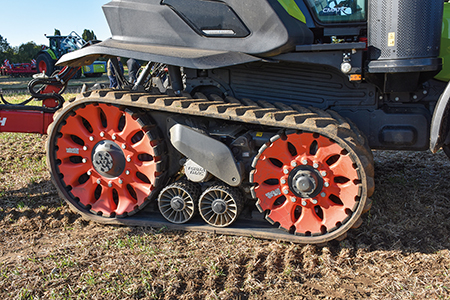

The Xerion 12
The Xerion 12 was launched to some overseas markets around 18 months ago, but here in the UK we have had to wait a little while longer while Brexit-related road homologations issues have been overcome. The upside to this, of course, is that any early teething problems have been eliminated and the machines coming into the UK now are very much snag-free.
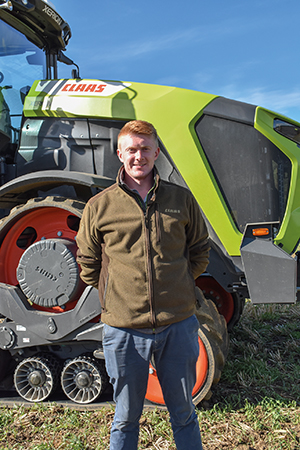
The Xerion 12 series is an extension to the long running range of wheeled high-output tractors that have been on offer since the late 1990s. The model on test in Suffolk was the Xerion 12.650, which, as the name suggests, offers 653hp. There is also a 12.590 model available with 585hp. The Xerion 12 is a new machine from the ground up with everything made bigger, but the Xerion DNA is still obvious.
The driveline comprises a 15.6-litre, six-cylinder Mercedes engine that, on the 650 version, produced 3,100nm of torque (2,850mm on the 12.590), which then goes through the constantly variable transmission. This delivers an easy and smooth drive when your implement is in the ground, and completely eliminates any ‘whip’ that you might get when changing gear with a traditional gearbox, and subsequently any wear that the ‘whip’ can cause on various components.
The obvious difference between this machine and any other Claas Terra Trac model is the triangular track drive system. These have been designed specifically to put large amounts of power to the ground and to pull big cultivators, and are unique in the Claas line-up to these two new models.
The Xerion 12 series has been designed as a field-based lugging tractor. There are no reverse drive options, no tool carriers… What you see is what you get. The two Xerion models mentioned are also sold as wheeled versions elsewhere in the world, but for the UK market they will only be available in Terra Trac configuration, largely due to the fact that putting 650hp through wheels required a dual wheel set up which makes them 5.5m wide and therefore not right for the UK market.
The tracked Xerion 12 can be used on the road, as it is within 3m width, and is said to be surprisingly nimble when used like this, despite its size.
New drive unit
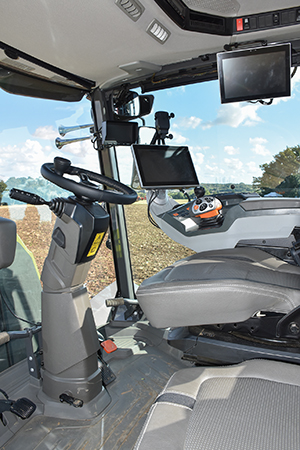
Patrick Frawley, product manager for high horsepower tractors at Claas UK, talked through the design of the Xerion 12. “At the top of the triangle you have your large drive idler. We don’t use a friction drive system here due to the amount of power we are putting through it. Instead, we use a positive drive system whereby the track has lugs on the inside that locate into cut-outs on the drive wheel.
“One of the key benefits of the Claas design over other triangular systems on the market is that we have the tightest angle on the top of the triangle. What this means is that we have the greatest number of lugs located in the drive idler at any one time – eight and a half to be exact. Because we have a rigid frame, rather than an articulated chassis, we can use a straight, fixed driveshaft rather than one that needs to articulate with the chassis and the problems that that brings with this amount of power. This increases simplicity and reliability.
“The lack of articulation also brings other benefits such as integrating the exhaust and the air intake into the frame using space that would have to be kept clear in an articulated machine. This means that we don’t need to run the exhaust up the side of the cab helping to improve all-round visibility. It also means that overall, the Xerion 12 is a little shorter than an articulated machine, although it does mean it is also a little higher, which I see as an advantage as height allows you to look down, rather than across your implement. So, when using something like a cultivator, the operator can look down into the frame and see what more of the legs are doing.
“We have four track steering, as well as 10-degree forwards and 10-degree backwards movement on the pivot, which is around double what you would see on any other triangular track unit on the market. This in turn allows us to have a completely flat belt which means that the belt running along the bottom of the triangle is flat to the ground. The front and rear lower idlers are carried on separate arms with the front idler weight supported by a rubber silent block to reduce the effect of any bumps being driven over. This means that the drive unit is not fully suspended, like our flat tracks, but neither is it fully rigid, like some other triangular tracks. This sits somewhere in between.”
It’s all about the weight
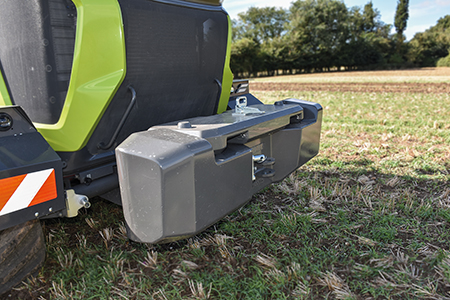
Other notable features of the new model include the positioning of the fuel tank. With an articulated machine this would normally be placed over the rear axle, but Claas has again used the rigid chassis to its advantage and placed a tank behind the cab, and another behind the steps below the cab, both inside the wheelbase of the machine, close to the centre of gravity and helping to maintain that 50:50 weight distribution. Together, these tanks will hold 1,400 litres of fuel.
The base weight of the machine, without an attachment or any additional ballast is 25,500kg, which makes it good for high-speed discing, high speed tilling and drilling etc. As the machine starts working the ground and the speed drops to around 12kph, you can add 1,800kg on the front. Work a bit deeper or wider, and at speeds of around 9–10kph, and you can add another 400kg on the front. If you need to work at subsoiling depths of around 16in, with a 6 or 7m wide attachment, you can add a further 1,000kg on the rear, bringing the maximum weight up to 28,700kg. The ballast can be added or removed singlehanded with pallet tines in around 15 minutes.
In the cab
Claas has equipped the Xerion 12 with a purpose-built tractor cab, rather than using an existing combine cab. The seat comes with 40-degree of swivel in either direction, providing almost 90 degrees of rotation in total for additional comfort and visibility.
At the headland, this large machine is very sprightly in the turns thanks to the Claas dynamic steering system, with just small amounts of wheel input delivering good turning angles. In fact, it’s somewhat surprising just how tightly the Xerion 12 can manoeuvre. When turning, the rear tracks turn less than the front tracks, unless you spec the machine without a rear linkage, in which case all four tracks move equally.
Driving the Xerion 12 is child’s play. Just engage the AB line, drop the cultivator and tap cruise control and you can stretch out in that spacious cab while the technology does all the work. You don’t need to think about gear changes, and there is no possibility of stalling the engine as the CVT transmission just effortlessly delivers the right power to the tracks all the time.
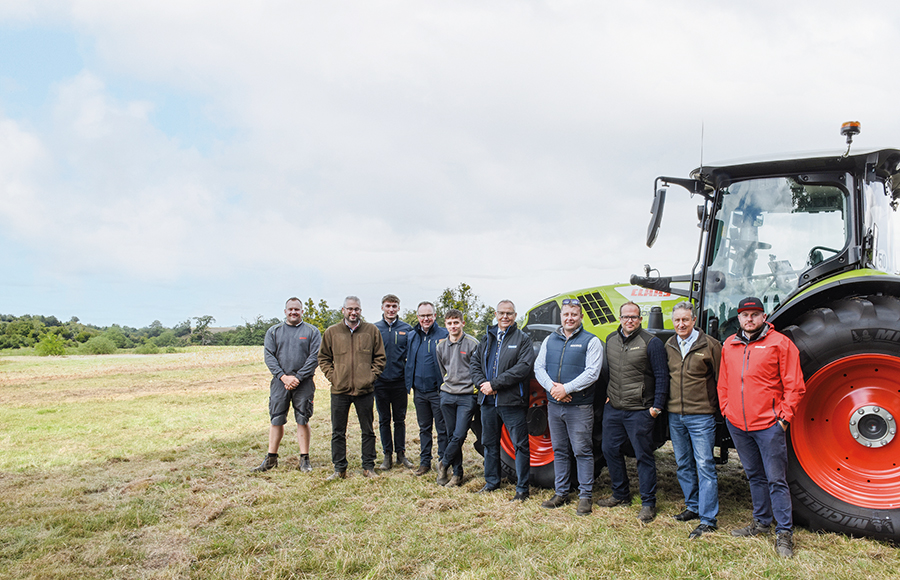
The ride is smooth with the four-point cab suspension and semi suspended track system taking out the bumps in the field brilliantly. During our test drive we were pulling a 6m Horsch Fortis AS set at 10in deep and typically saw fuel burn of around 70 litres per hour and a work rate of 7.5ha per hour at a speed of 12kph.
Whilst the Xerion 12 has four track steering, when it is locked onto the AB line the rear tracks are fixed and the steering is just undertaken by the front tracks, which removes any twitchiness that you might experience with an articulated machine.
Read more machinery news



